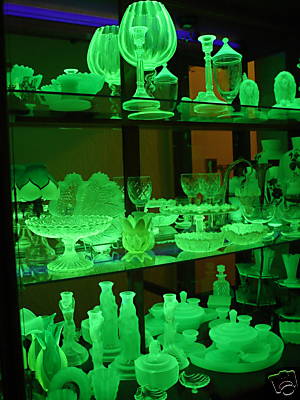

Perhaps the most reliable way to identify the presence of uranium in the glass is to expose it in the dark to a source of ultraviolet light (e.g., a black light). To confuse matters somewhat, this non-Vaseline glass might even be radioactive due to the presence of thorium impurities! Some transparent yellow or yellow-green glass has been colored using additives other than uranium (e.g., cerium oxide), and it can look exactly like Vaseline glass. Canary glass is an even older name that was first used in the 1840s to describe what is now referred to as Vaseline glass. Uranium glass, an older and more general term, is sometimes used as a synonym for Vaseline glass, but this can lead to confusion because some types of glass colored with uranium (e.g., custard glass and Burmese glass) are opaque whereas Vaseline glass is transparent. Vaseline glass is a recent term that probably dates from the 1950s. These cognoscenti might describe it as “Depression Glass,” a less desirable commodity. Purists might argue that the green sugar bowl in the picture should not be considered Vaseline glass because an additional colorant (probably iron) has been used in addition to the uranium to produce the green. It may be obscured by other fluorescent species or colorants.Vaseline glass, like the candlestick holder shown here, is a term for the transparent yellow to yellow-green glass that owes its color to its uranium content. Sb (Antimony) - A bluish, whitish often rather weak fluorescence. The greenish-yellow might be absorbed by the purple color of the body of the glass itself.

Mn usually requires a level of ~ 0.5% (?) to be readily visible.

This is usually not at all a strong fluorescence. Mn (Manganese) - A moderately strong "lemonade-like" greenish-yellow, often somewhat turbid. The Pb fluorescence is an icy-blue color and emanates from within the body of the glass.) (Don't mistake the reflection of visible purple light from the UV lamp for Pb fluorescence. Pb normally fluoresces more strongly than manganese or antimony. High-lead glasses are usually colorless. The fluorescence becomes noticeable at a level of about 5%, and is strong by about 10-15%. The fluorescence is visible under both long-wave and short-wave UV. Pb (Lead) - A strong icy-blue response, but not normally as strong as U. Ancient glasses contain at most a few ppm of U - not nearly enough to cause any UV fluorescence. The color is usually obtained by adding ~0.5 % U2O3. Once you have seen the color, you will remember it. You can tell a uranium-containing glass just by looking at it. The color of the glass itself in visible light is usually a bright yellow or yellowish-green, or an amber color in a lead matrix. U (Uranium)- A very strong bright-green response. Leaving out the exotic elements not found in ordinary glasses, the responses are more-or-less as follows: The fluorescent response depends on several factors: primarily the elements present, sometimes matrix effects, the concentrations, the wavelength of the exciting radiation, the intensity of the exciting radiation, possibly the redox state of the elements, colorants that might be present, etc.

There are several elements that will cause common glasses to fluoresce. Robert Brill, Research Scientist Emeritus: 17 Lampworking/Flameworking/Scientific GlassblowingĮxample of uranium glass.4 Glass Labor History/Working Conditions.


 0 kommentar(er)
0 kommentar(er)
